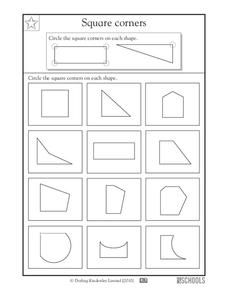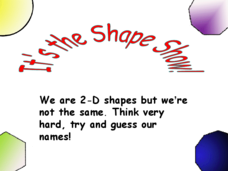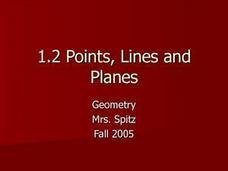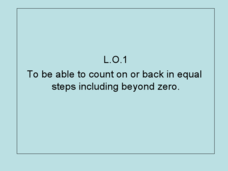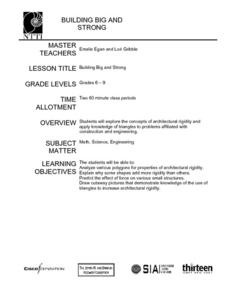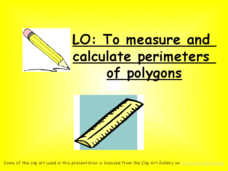Curated OER
Properties of Polygons, Same-Length Sides
Can your third graders spot the differences between these geometric shapes? After studying several sections of triangles, rectangles, and other polygons, learners circle the shape described in each set of instructions. For extra...
Curated OER
Properties of Polygons, Parallel Sides, and Right Angles
Have fun with shapes! Third graders read a set of instructions and circle the shape in the description. They work on recognizing parallel sides and right sides. Use this resource as homework after your geometry lesson.
Curated OER
Tiling the Classroom
Students see how to identify regular polygons, how to slide, turn and flip polygons, and why certain polygons tessellate better than others. Groups create a one foot square design to be used to tile the classroom. Great lesson!
Curated OER
2-Dimensional Shapes: Naming Shapes
Get to know eight shapes by name: square, rectangle, triangle, pentagon, hexagon, and octagon. Young geometers write the correct name below each of these shapes, using a word bank for guidance. Then, they draw two of the shapes (hexagon...
Curated OER
Sorting 2-Dimensional Shapes
Explore shape attributes with young geometers as they sort nine shapes based on their corners. Scholars determine whether or not each shape has a square corner, drawing it in the appropriate space accordingly. They are encouraged to use...
Curated OER
Square Corners
Which ones are square corners? As they learn more about shape attributes, be sure scholars understand the difference between a vertex and a square corner. After examining two examples, learners circle the 90-degree corners in 12...
Curated OER
Dihedral Figures
Middle and high schoolers perform transformations. In this web based lesson, young scholars explore dihedral figures. They use the web tools to translate, rotate, and reflect figures. Pupils identify lines of symmetry.
Curated OER
Transformations - Rotations in the Coordinate Plane
In this geometry lesson plan, math scholars brainstorm examples of rotations. Using the SMARTboard, students observe a rotation. They create their own rotation using graph paper. Finally, pupils complete a worksheet and graph rotations.
Shodor Education Foundation
Visual Patterns in Tessellations
Geometers explore the concept of tessellations. They use a tessellation applet to manipulate shapes and design their own tessellation using the applet.
Curated OER
2-Dimensional Shapes: Drawing Shapes
Some of the best practice with shape identification comes from drawing the figures first-hand. Young geometers draw nine two-dimensional shapes: rectangle, circle, square, pentagon, hexagon, octagon, triangle with three equal sides,...
Curated OER
Hands-On: Sums of Angle Measures
In this angle measures activity, students solve six word problems where they are given 6 different polygons, some of which are complex, and must determine angle measures in order to arrive at a solution.
Curated OER
The Shape Show
Define plane shapes by their properties, then use this game to reinforce those skills. Learners use given properties as clues to determine each shape. They work to name ten different shapes, six of which are polygons.
Curated OER
1.2 Points, Lines and Planes
This is a lengthy overview PowerPoint that defines, explains, shows examples, and has practice problems about points, lines and planes. The class will need to write many notes and there is an example of how to set up in the Cornell...
Curated OER
Year 5 Unit 2b
This slide-show is packed with information relating to a variety of mathematical concepts. Intended as an accompaniment to a full unit, this resource provides definitions, explanations, and opportunities for learners to practice their...
Curated OER
Classifying Polygons
A straight edge, a right angle, a number of vertices; sounds like it's time to classify polygons. That's right you and your class will learn all about the properties of polygons and how to classify them with this easy to follow...
Curated OER
2D Shapes
This engaging presentation would be helpful for your young learners of geometry. Pupils are given clues as to what a shape may be, then they have to use those clues to guess what shape is being described. Shapes used are the circle,...
Curated OER
Measures Combined
Use this resource to teach perimeter of regular plane shapes, measurement, rounding, and systematic problem solving skills. There are 78 complete slides and two game suggestions intended to facilitate content understanding.
Curated OER
Year 5 Unit D1
This presentation is intended to accompany an entire unit and covers a wide variety of concepts. Counting on, counting back, symmetry, properties of 2-D shapes, completing symmetrical patterns, and measuring angles are all covered.
Curated OER
Building Big and Strong
Middle and high schoolers explore the concepts of architectural rigidity. They analyze a variety of polygons, and explain why some shapes add more strength to structures than others. The PBS video, "Building Big," is utilized in this plan.
Curated OER
Poly-Mania
This hands-on lesson takes young geometers on a tour of 2D polygons and 3D polyhedrons. After exploring different web resources and discussing geometric shapes, small groups construct models of polyhedrons using bendable straws. Note:...
Curated OER
Calculating and Measuring Perimeters of Polygons
If you're teaching 3rd or 4th grade math, this presentation is a must have. It defines perimeter and polygons, then describes the process by which perimeter is determined through pair share discussion and critical thinking questions....
Curated OER
Measuring Area: Sensible Flats
Here's how to calculate the areas of polygonal figures. In this measuring area lesson, upper graders use hash marks to create and count square units. They also problem solve a cyberchase activity watching Quicktime videos.
Curated OER
"Polly"gon Pockets
Explore polygons with your elementary learners. Divide the class in 12 to configure the polygon puzzle before them. They list the attributes of each type of polygon they see, and if there's time, they jump on the interactive website...
Curated OER
The Very Busy Spider
Youngsters explore visual arts by participating in a geometry identification activity. They read the book The Very Busy Spider and identify the techniques spiders use to create webs. Have you ever noticed that their webs are geometric...







